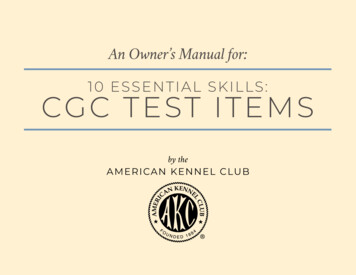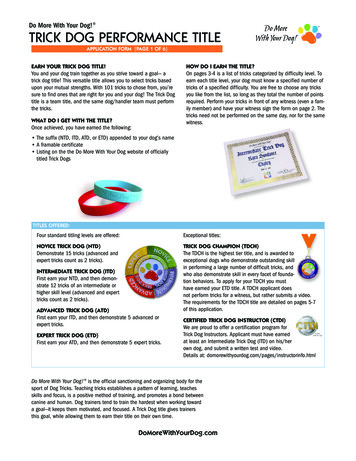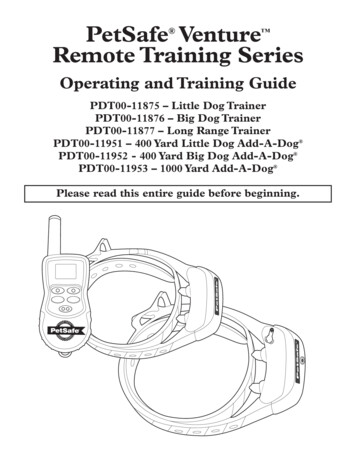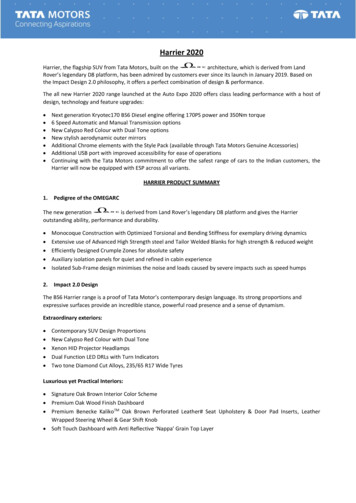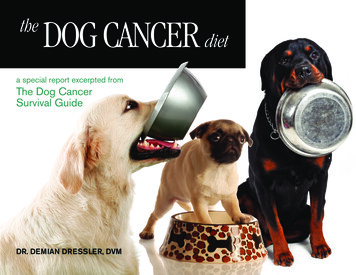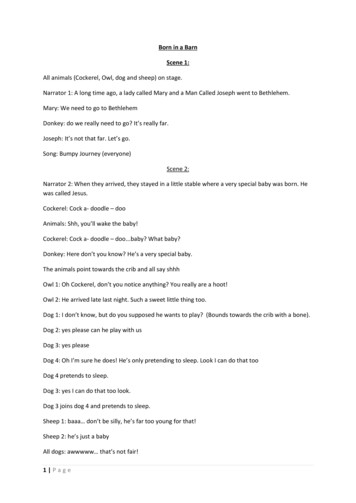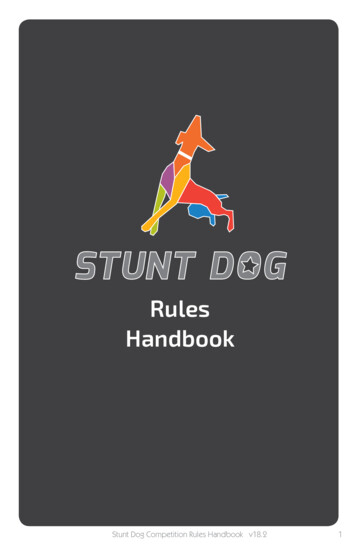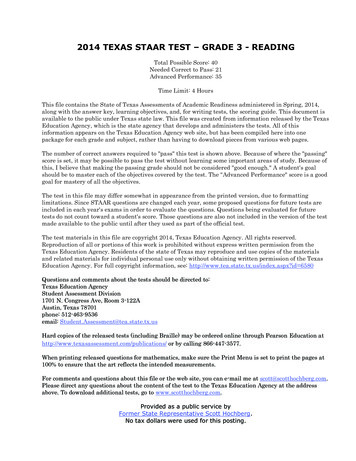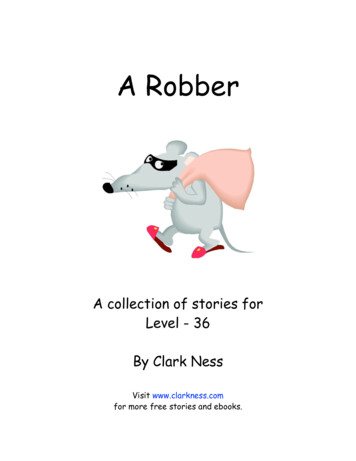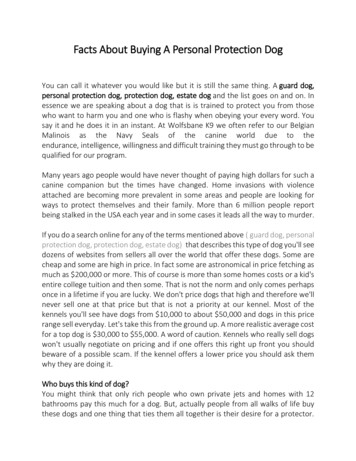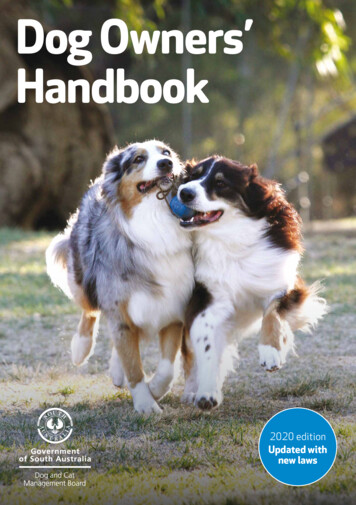
Transcription
Dog Owners’Handbook2020 editionUpdated withnew laws
Contents04050610171826293235The benefits of owning a dogChoosing your dogOwning a dogDog trainingSafetyCaring for your dogYour dog and the publicDogs and childrenDog park etiquetteWhere can I get advice?Dog and CatManagement BoardGPO Box 1047Adelaide SA 5001Telephone: (08) 8124 4962Email: dcmb@sa.gov.auwww.gooddogsa.com.auISBN 978 1 921800 04 7Photo AcknowledgementsSeahorse Photography:Cover, Page 5, 9, 13, 15, 16, 17, 22, 23, 25, 27
Owning a dog can enrich yourlife in many ways, but it’s a bigcommitment to your dog and thecommunity. This is your guide tosocially-responsible dog ownership.In the book you will find: information on how to care for your dog strategies to prevent your dog causingpublic nuisance or injury information on the legal requirementsfor owning a dog in South Australia.It is important to remember that your dog is dependent on you to provideits food, water, shelter and the activities necessary for its physical andmental health. This commitment to your dog could last for at least 15 years,so investing in the establishment of a great relationship from the verybeginning will be rewarded by years of happiness together.If you require any further information on any of the topics covered in this book,please refer to the list of resources on the inside back cover, or ask your vet.Good dogs have great owners.03
The benefits of owning a dogThere are many reasons why peoplechoose to own a dog.People with dogs and other pets oftenlive longer, healthier lives, with bettercardiovascular health, lower bloodpressure and lower levels of anxiety,than those without animal companions.Having a dog in the family can help childrento develop a sense of responsibilitytowards other living things as they learn tocare for it. Looking after and exercising adog also provides health benefits for boththe dog and the child, when undertakenresponsibly and safely.Choosing the dog that is right for you, yourfamily and your circumstances is a bigresponsibility. It is important that thedecision is not made on impulse, and that youconsider both your needs and those of thedog. A poor choice can lead to unhappinessfor you, your family and your dog.Factors to consider before choosing a dog: How big is your garden and what type offencing and gates do you have? How much time can you spendat home with the dog? Can you afford the food,vet and registration costs? How much time can you committo training, exercising andgrooming your dog? Does your general lifestyle suit a dog? What will you do withyour dog if you travel? What are the ages of anychildren living in the home? Will your dog be allowed insideor have to stay outside?04
Choosing your dogWhile there are many issues to considerbefore getting a dog, you and yourfamily should be able to find a dogto suit your lifestyle.If you would like to see or interact withvarious breeds of dogs, you could attenda dog show (see www.dogssa.com.aufor a calendar of events) or visit yourlocal dog training club.Animal shelters such as the RSPCA orAnimal Welfare League have many dogsin urgent need of loving homes and thedetails for these organisations can befound at the back of this book. Shelterstaff can also offer valuable adviceregarding which dog might be bestsuited to your family and lifestyle.05
Owning a dogBasic responsibilitiesBy law, you are required to provide your dogwith the basic requirements to meet theirwelfare needs. That means your dog musthave access to clean water, food, appropriatesleeping conditions, shade from the hot sunand enough exercise to be healthy and happy.Owners can do this by logging intoDACO and updating their record.Dog registration fees are used byyour council for the administration orenforcement of dog and cat management,including dog parks, animal managementteams and pound facilities.RegistrationMicrochippingAll dogs over three months of age must beregistered via the Dogs and Cats Online(DACO) website.Microchipping is an extremely reliablemethod of identification which greatlyincreases the chance of your dog beingreturned to you if it becomes lost. A smallmicrochip, about the size of a grain of rice,is implanted under your dog’s skin by a vetor other qualified person. Each microchiphas its own unique number.All registered dogs are issued with apermanent registration number on a greydisc following first registration. Ownersmust affix the issued disc, or one of theirchoice displaying the permanentregistration number, to the dog’s collar.Registration expires 30 June and must berenewed on DACO by 31 August each year.The permanent registration numberremains the same each year. Replacementdiscs may be purchased on DACO ifrequired, or a metal disc may be used.To register a dog, you must be over 16years of age and you must inform yourlocal council within 14 days if: you have a new dog your dog has moved to differentpremises (registration can betransferred between local councils) your dog is missing ownership of the dog has transferredto another person your dog dies.06Your dog’s microchip details are requiredto be recorded on DACO which can beaccessed by councils, vets, animal welfaregroups and dog shelters.All dogs in South Australia mustbe microchipped. A dog must bemicrochipped before it is sold or before 12weeks of age or within 28 days after takingpossession of the dog. Microchipping is nota substitute for council registration.
07
Owning a dogDesexingThere are many good reasons to desex yourdog. It reduces the risk of certain cancers,stops unwanted litters and makes it lesslikely your dog will roam.Desexing your dog is compulsory in SouthAustralia. Dogs born after 1 July 2018 mustbe desexed by six months of age. There areexemptions for working livestock dogs,racing greyhounds, dogs belonging tobreeders registered with the Dog and CatManagement Board, or on medical grounds(i.e. unacceptable anaesthesia risk).Mandatory desexing has been introducedto help reduce the number of unwanteddogs in the community.SocialisationResearch has shown that a puppy’sexperiences in its first 12 weeks of life willstrongly influence how it reacts to the worldas an adult dog. Failure to expose a youngpuppy to a wide variety of situations canresult in it being fearful of particularcircumstances, people or animals for therest of its life. It is vital that your puppy’ssocialisation is approached with a plan thatprovides a range of positive experiences.08These experiences may include safelyexposing your puppy to: men and women children of different ages people with loud voices quiet and busy places street sounds other animals normal household soundssuch as a vacuum cleaner music different smells.It is important to ensure that any form ofsocialisation is a positive experience foryour puppy and that constant supervision,reassurance and encouragement are provided.By keeping your puppy’s favourite treatson hand, any new experience and situationcan be reinforced as a positive association.It is also important to seek advice fromyour vet regarding situations that shouldbe avoided until your puppy is fullyimmunised. Many clinics offer puppyparties or socialisation classes. These canbe a great way for your puppy to meetother dogs in a supervised environmentwhere the risk of illness can be minimised.
09
Dog trainingDog training is an important part ofbuilding a happy, healthy relationshipwith your dog. It sets consistentboundaries and provides your dog with aclear understanding of what is expected.Dog training can be undertaken with yourdog at any age, unlike social exposuretraining which must be done before yourpuppy is 12 weeks old. There are numerousways to train your dog. You can: teach your dog at home join classes at a local dog training club engage the services of a private dog trainer. Food treats can be used to reward dogsduring training sessions. Dogs lovethem, so they can be a very effectivetraining tool. Try to minimise distractions when youare training your dog. The dog mustbe focused on you. The local park withexcited children running around is notan ideal place for training.Sit‘Sit’ is commonly the first command thatyoung dogs learn and is an importantmethod of basic training.If you choose to use a dog training club, yourlocal council, RSPCA or a quick internetsearch for positive reinforcement dog trainingwill help you find a club in your local area.Training tips:It’s a good idea to teach the basiccommands of ‘sit’, ‘stay’, ‘come’, ‘drop’ and‘heel’. Whilst there are many othercommands you may wish to teach your dog,these five basic ones will give you a level ofcontrol and trust in your dog’s behaviour. Slowly move the food up and back overthe dog’s head towards its tail.General training tips Try to make training a positiveexperience for both you and your dog. Training should be performed in shortsessions (of five to ten minutes) severaltimes a week, so the dog does notbecome bored. Always end the training session ona positive note and demonstrate toyour dog that you are happy with it.10 Hold a piece of food (or a dog treat)between your thumb and forefinger. Position the food just above the dog’s nose. The dog should automatically look up inthe direction of the food and move backinto the sitting position, with its bottomon the ground. As your dog is moving into the sittingposition, say the word “sit” once ortwice, to create an association betweenthe action and the word. Once the dog is in position give it thereward and praise it in a positive tone ofvoice. If the dog has to jump up to get thereward, you are holding the treat too high.Stay‘Stay’ is another important command toteach your dog. This command is veryimportant for your dog’s safety.
11
Dog trainingTraining tips: You should begin training with yourdog on a lead.dog’s name followed by “come”. Makesure you use a positive tone of voice. Start with your dog in a sitting positionat your left-hand side. Gradually increase the number ofsteps taken while calling the dog’sname and the command. Place your open hand in front of the dog’sface, and say “stay” in an authoritative tone. Praise or reward your dog whenit responds to your command. Step in front of your dog, waitmomentarily, then say “stay, good dog”and reward the dog with a treat. If training at home, or within a safe fencedarea, you can progress to off-leadtraining once your dog is consistentlyachieving the on-lead version. Repeat this process, slowly increasingthe length of time your dog needs towait before being rewarded. As your dog becomes better at holding thestay position, start taking steps backwardsuntil you are at the end of the lead. You should be confident of your dog’sability to come when called beforeattempting this at an off-lead dog park.Walking on a loose lead The stay command can also be practisedwith the dog in a standing or lying position.When exercising your dog in public, bylaw, it must be on a lead of no more thantwo metres, unless you’re in a designatedoff-leash area. Teaching your dog to walksafely by your side on a loose lead willmake your walks much more enjoyable.ComeTraining tips:Teaching your dog to come to youon command is important if you wishto have effective control over it. Normally, dogs are walked on theleft-hand side of the handler and thisis how you should commence training. If training at home, or within a safe fencedarea, you can practise off-lead stays oncethe on-lead version has been mastered.The number one rule when teaching yourdog to come is that there mustbe a positive outcome when it comesto you. If you call your dog to you in orderto punish or discipline it, it will quicklybecome discouraged from respondingto this command.Training tips: Hold your dog’s lead in your lefthand and a treat in your right hand. Take a few steps backwards, calling your12 The correct position for your dog whenwalking on a loose lead is for its head/shoulder to be in line with your left leg.The lead should make a letter ‘J’ fromyour hand to the dog’s collar. Whilst the dog is in the correct positiontell it “heel, good dog” in a positive toneof voice and reward it with a treat. In the early stages of learning this newskill, your dog should receive a small treatevery few steps. Increase the number ofsteps between treats as your dog
becomes better at loose lead walking. If your dog walks out in front of you, orlags behind you, slow down dramaticallyor even stop. When your dog realisesthat you have stopped, encourage it toreturn to the starting position at yourleft side. When it is beside you again,resume walking at normal pace. Remember to praise and reward yourdog when it is doing the right thing. Your dog will learn quickly that when itpulls in front of you, or lags behind you,its walk slows down or stops, but when itis in the correct position the walk continuesand it receives praise and treats. Be prepared for slow walks the firstfew times that you take your dog forloose lead training. It may take an hourto go on a ten-minute route, but thedog will learn quickly that the moreit pulls in front or behind, the lessquickly the walk progresses.Reprimanding your dogIf your dog does something inappropriate,or that you do not like, reprimanding willonly work if it is done immediately. A dogwill not understand why it is in trouble if itis disciplined hours, or even just minutes,after an incident and will become confused.This can lead to your dog becomingcautious around you until trust is rebuilt.House mannersIt is a good idea to set boundaries for yourdog when it first comes to your home. Itis important for your dog to have its ownarea within your home. This should be awayfrom the busiest parts of the home sothat it can provide a retreat for your dogwhen it needs some quiet time. The areashould have a food bowl, a water bowl andcomfortable bedding. If it is outside, itshould be well shaded and shelteredfrom sun, wind and rain.13
Dog trainingSleepingGardeningDogs enjoy having their own bed and willretreat to this when in need of a space oftheir own. Many owners establish their dog’sbed in the laundry or family room in a quietcorner, away from the hustle and bustleand direct access by unsupervised children.Some dogs are enthusiastic gardeners,creating large holes in your garden beds,lawns or even hoses. Dogs dig for a varietyof reasons, including boredom and lack ofexercise, and some breeds have more of atendency towards this behaviour than others.Kitchen and eating areasIt is advisable to train your dog to be on itsbed while meals are being prepared, or thefamily is eating. It is unwise to feed your dogfrom the table as dogs can quickly learn tobecome scavengers. All treats should begiven on your terms, not on the dog’s demand.VisitorsYou want guests to feel comfortable whenvisiting your home, so it is important toteach your dog good manners.Jumping up on people is a very commonproblem which can be discouraged withpractice and training with family membersat home. Quietly turn your body away fromthe dog, do not make eye contact and keepyour arms still at your side. As soon as yourdog has four paws on the ground, reward it.With consistency from everyone who comesinto contact with your dog, the problem ofjumping up should quickly be resolved.14Digging incidents can be decreased, oreven eliminated, by ensuring that your doghas a variety of toys to keep it occupied.Rubber toys stuffed with treats willprovide entertainment for a time, as canballs, plastic bottles, chew toys, squeakytoys and rawhides.If your dog continues to dig in your garden,one possible solution is to set up its ownarea for digging. Provide your dog with itsown patch of garden, or even a sandpit,and encourage it to dig there by buryingbones or toys in that location.Behavioural issuesDogs can easily develop undesirablebehavioural issues. Owners oftenunknowingly reward negative behavioursuch as jumping up. If your dog developsa habit or behaviour which is affectingyour lifestyle and you are unable to finda solution, you should seek professionalhelp from your vet or a qualified dogbehaviourist or trainer.
15
Dog trainingChewingSome dogs, particularly puppies whomay be teething, can be quite destructivewith their chewing. It is important thatthe puppy learns what is acceptable tochew, and what is not. There are manytoys available, such as hard rubber balls,rawhide chews and squeaky toys, on whichyour puppy can chew. They are designedto be hardy and to facilitate the transitionfrom baby to adult teeth.It is not advisable to give your dog oldshoes to chew, as it will not understandthe difference between old shoes anda brand-new pair.If you find your puppy (or dog) chewingon something undesirable, take the itemaway and replace it immediately with an‘approved’ toy.Toilet trainingWhether you have acquired a puppy or anolder dog, some form of toilet training willbe required.Puppies need intensive toilet training tocondition them to communicate to youwhen they need to go. They must also learnwhich areas of the garden are acceptableplaces to go to the toilet.An older dog, who may already be toilettrained, will still need to be taught wherethe acceptable toileting areas of its newhome are located.It is important that you, as the owner of thedog, set the boundaries about which areasof your garden your dog can use as a toilet.There are times when a puppy is mostlikely to need to go to the toilet and yourinitial training should be based around anawareness of these times. They include: when your puppy has just woken up when your puppy has had a drink when your puppy has eaten after an extended period of play.Another sign that your dog or puppymight need to go to the toilet is if it startscircling and sniffing the ground.You should be watching and waiting inorder to take advantage of your dog’snatural desire to go to the toilet at thesetimes. Make sure that you reward your dogfor a successful toilet trip.If your dog is taken outside every timeit needs to go to the toilet, it will beginto make the association that it must gooutside to go to the toilet. Eventually, yourdog will go to the door when it needs togo to the toilet. When your dog is toiletingyou can give a command such as “go toilet,good dog” and reward it with a treat or pat.16
SafetyAs a dog owner, it is your responsibility toensure that your dog is safely containedon your property. Your fencing or othercontainment measures must be secureenough to keep your dog in and otheranimals out.If your dog is in a public or private placewithout the consent of the owner and is notunder the effective control of someone, itis considered to be ‘wandering at large’.This is an offence under the Dog and CatManagement Act 1995 and, as such, theregistered owner is liable for expiationfees or a fine.Lost dog? Log in to DACO and check your contactdetails are up to date. Update your dog’sstatus to ‘lost’ and set a public message.If you find a wandering dog, contact yourcouncil. They have trained staff on handto collect lost dogs and keep them safeuntil the dog can be returned to theregistered owner.Members of the public can look up thedog’s registration number on DACO tocontact the council the dog is registeredwith or the owner if a ‘lost’ message hasbeen set.Please note: An impounded dog is onlyrequired to be held by councils for aperiod of 72 hours, after which time,if the dog remains unclaimed, the councilcan dispose of the dog or transferownership to a third party (Dog andCat Management Act 1995). Contact your council, the RSCPA andAnimal Welfare League and local vets assoon as possible – your dog may havebeen collected and taken to a shelter. Post current pictures and descriptionsincluding the time/place last seento social media or communitynotice boards.17
Caring for your dogVeterinary careA relationship with a local vet is important tothe care of your dog. As soon as you get yourdog, you should book them in for their firstvet check up, just to be sure they’re healthyand happy. Your vet can provide advice onboth health and behaviour-related issues,and is there to help you look after yourdog, so do not be afraid to ask questions.DietProtein, calcium, minerals, vitamins andcarbohydrates all play an important partin maintaining the health of your dog.Whether you choose to buy commercialfood, or make your own, it must contain abalance of all these nutrients.At each stage of life your dog will havedifferent dietary requirements. An activepuppy will have greater calorific needsthan an older dog and will require morefrequent meals.It can be difficult to decide the type andamount of food to feed your dog. Consultingyour vet, other dog owners, breeders orDogsSA will provide more information. Ifyou purchased your dog from a breeder,they will certainly be able to give youadvice on feeding. Remember that thecheapest diet options may not be themost suitable for your dog and couldlead to health problems resulting frominadequate nutrition.18Please note: Dogs should never be fedcooked bones as they splinter easily andcan cause life-threatening constipation orintestinal damage. Raw meaty bones aresuitable for most dogs and have the addedbenefit of helping to keep your dog’s teethclean. There are also dry foods and chewtreats made specifically for the purposeof improving your dog’s dental health. Yourvet or breeder will be able to advise onwhich might be suitable for your dog.Weight ControlWeight control is not just a human problem;dogs can also become overweight. Excessweight places a strain on your dog’s jointsand organs, affects its general wellbeingand can lead to life-shortening conditions,such as diabetes.A healthy dog will have a light coveringof flesh over its ribs and torso and whenviewed from above, will have a definedwaist. If your dog is at its correct weight,you should be able to feel its ribs andbackbone with a small amount of pressure.The diagrams and explanations to the leftwill assist you in managing your dog’sweight and keeping it in optimal condition.You can monitor your dog’s weight withregular weighing. For small dogs youcan use your household scales, but for alarger dog you will need to use the scalesavailable at vet clinics. Remember thatkeeping your dog’s weight within a healthyrange will not only be good for your dog,but will also avoid unnecessary visits tothe vet for treatment of preventable,weight-related conditions.
IDEALEMACIATEDTHINOVERWEIGHTOBESEDept of Primary Industries (Vic), Code of Practice for the Private Keeping of Dogs (Vic)19
Caring for your dogPoisonsThere are a number of foods, plants andchemicals that are toxic to your dog. Somemay only give them an upset stomach,but others can have far more seriousconsequences and could even cause death.If you have any concerns about somethingthat your dog has eaten, you shouldimmediately contact your vet for advice.The list below provides the names ofsome common foods, plants and othersubstances that should be avoided. Thereare many more, so your own researchshould supplement this list.Toxic foods and substancesthat should be avoided: alcoholic drinks chocolate garlic grapes and raisins products containing caffeine mushrooms hops onions tobacco potato. Wisteria Narcissus Cyclamen Lantana.Household chemicals can also be harmful toyour dog. Insecticides, household cleaners,snail/slug baits, rodent baits, fertilisers, andeven human medications, can all have seriouseffects on your dog if ingested, inhaled orabsorbed. These items must be stored in anarea which cannot be accessed by your dog.If you need to use chemicals in an area thatyour dog frequents, such as the garden,research carefully beforehand to ensurethat you do not accidentally harm your dog.The internet is a useful resource forresearching toxic plants, foods andsubstances, but if you require furtherinformation contact your vet.Vaccination and wormingVaccinationThere are three canine vaccines thatare considered ‘core’ vaccines and all dogsshould have these administered. They are: Canine Distemper Virus Canine AdenovirusToxic plants that should be avoided: Canine Parvovirus. Lily of the ValleyOther non-core vaccines may be consideredappropriate for your dog. A kennel coughvaccine might be required if your dog isgoing to be in close proximity to largenumbers of other dogs, such as at dogtraining classes, boarding facilities,or dog parks. Many non-core vaccinesrequire annual administration. Tulips Chrysanthemum Rhubarb (leaves) Bulbs of hyacinth or daffodil Azalea English Ivy20
Puppies have a specific vaccinationschedule that is designed to give themmaximum protection against disease. Thisschedule means they will receive two orthree vaccinations, with the last one beingat approximately 16 weeks of age. Whenpurchasing a puppy, ensure that you aregiven an up-to-date vaccination certificate.A breeder must provide you with this andif you are purchasing a puppy, it must alsobe accompanied by a current vaccinationcertificate (South Australian Standardsand Guidelines for Breeding and TradingCompanion Animals).If you have any questions or wishto discuss your dog’s vaccinationrequirements, speak to your vet.WormingThere are five main types of wormthat can affect your dog: roundworm,hookworm, tapeworm, whipworm andheartworm. These cause varying degreesof complications, with heartworm beingthe most serious. Heartworm is spreadby mosquitoes and if left untreated, canbe fatal for your dog. It is easy to avoidworm infestations by regularly usingpreventative medications.Speak to your vet about the best wormingregime for your dog. Your vet can adviseyou on which worms are most prevalent inyour area, which medication you should useand how often it should be administered.Regular worming also minimises thechance of parasite transmission to humans.To further reduce this risk, always washyour hands after handling animals.Flea controlFleas are tiny, black, blood-suckingparasites that can make your dogextremely uncomfortable and ill.They are commonly found in allareas of South Australia.If your dog has fleas, it may exhibitthe following symptoms: frequent scratching small red marks (bites) on the skin black gritty material in the coat.Close inspection of your dog’s skin canreveal the fleas themselves, which areusually concentrated around the lowerback or base of the tail.Some dogs are allergic to fleas and, oncebitten, can develop flea allergy dermatitiswhich can have serious consequences,such as severe itching or self harm dueto intense irritation.Flea treatment and prevention can takethe form of topical applications, sprays,shampoos or collars. When treating yourdog for fleas, you must also considerother items or areas that your dog uses.This includes its bed and bedding, as wellas soft furnishings, carpets and rugs.Vacuuming, washing, mopping, spraying andthe use of flea bombs may be required. Ifusing chemicals, you will need to considertheir suitability for animals and any familymembers with allergies.Further advice regarding the control offleas can be obtained from your vet.21
Caring for your dogBathingGroomingAll dogs need to be bathed regularly,regardless of the length of their coat.Bathing encourages the shedding of hair,allowing for new growth and will keepyour dog’s coat and skin clean andprevent it from becoming smelly. Youcan bath your dog yourself, take it toa grooming salon, or use a mobile doggroomer who will come to your home.Grooming covers many aspects of caring foryour dog, including brushing, coat clipping,ear cleaning, teeth cleaning and nail clipping.When bathing your dog, it is important touse a shampoo that is specifically designedfor dogs. Human shampoo is not suitablefor dogs as they have a different skinpH level from us. Using an inappropriateshampoo can result in major skin irritationand discomfort for your dog.If possible, your dog should be bathed ona warm day. If you are washing your dog ona cooler day, you should towel dry the dogthoroughly and allow it to dry completelybefore going outside. A professionalgroomer will use a dryer to ensure thatyour dog is completely dry before itleaves their salon, or the groomerdeparts from your house.As your dog is drying, gently brush itscoat to remove loose hair and moveexcess water to the end of the hair,making the drying process easier.22How often you brush your dog’s coat will bedetermined by the type of coat it has.Short, harsh-textured coats generally needless brushing than long, silky or curly ones.However, all dogs need to be brushed asit helps to remove loose hair and dirt.For a dog with a higher-maintenance coat,brushing prevents tangles and mats, makingyour dog more comfortable and reducing theneed for frequent clipping or trimming.Basic clipping and trimming can be done athome, while more complex grooming shouldbe left to a professional. Again, it dependson your dog’s coat type and the amount oftime you can dedicate to grooming your dog.Nails can also be cleaned or trimmed, orteeth and ears cleaned, by a groomer, or athome. If you wish to learn how to do this,ask your vet for more information.
23
Caring for your dogTravellingIf you are planning to take your dog in thecar, whether for a short trip to a friend’shouse or on a road trip around Australia,you need to consider the following: Dogs should never be left unattendedin a car. Even on a cool overcast day,the temperature inside a locked car canincrease very quickly. Dogs can begin tosuffer the effects of heat stress withina few minutes and death can followshortly thereafter. The owner or personin charge of a dog who suffers ill effectsafter being left in a car can be finedunder the Animal Welfare Act 1985. When in a car, your dog should besecured behind a cargo barrier, in atravel crate, or harnessed to a seatbelt. This is important for the dog’ssafety as well as that of others. Inthe event of an accident
Dog training can be undertaken with your dog at any age, unlike social exposure training which must be done before your puppy is 12 weeks old. There are numerous ways to train your dog. You can: teach your dog at home join classes at a local dog training club engage the services of a private dog trainer.
